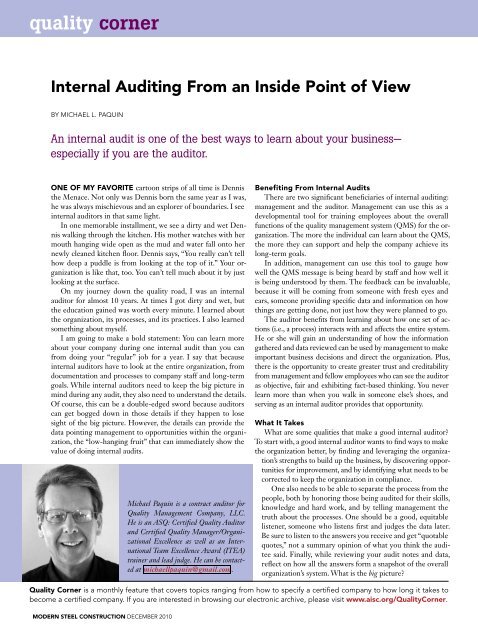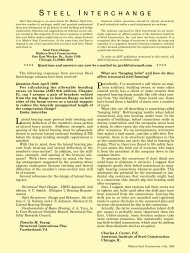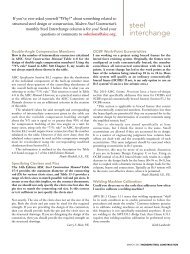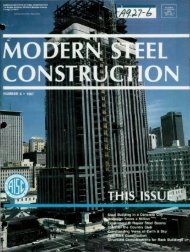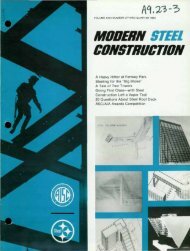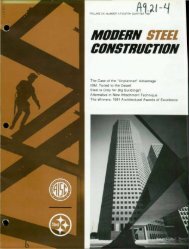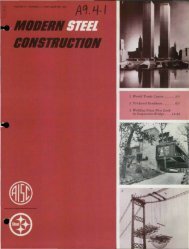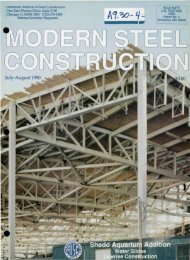Internal Auditing From an Inside Point of View - Modern Steel ...
Internal Auditing From an Inside Point of View - Modern Steel ...
Internal Auditing From an Inside Point of View - Modern Steel ...
You also want an ePaper? Increase the reach of your titles
YUMPU automatically turns print PDFs into web optimized ePapers that Google loves.
quality corner<br />
<strong>Internal</strong> auditing from <strong>an</strong> <strong>Inside</strong> <strong>Point</strong> <strong>of</strong> view<br />
by mIchael l. PaquIn<br />
An internal audit is one <strong>of</strong> the best ways to learn about your business—<br />
especially if you are the auditor.<br />
ONE Of My favORITE cartoon strips <strong>of</strong> all time is Dennis<br />
the Menace. Not only was Dennis born the same year as I was,<br />
he was always mischievous <strong>an</strong>d <strong>an</strong> explorer <strong>of</strong> boundaries. I see<br />
internal auditors in that same light.<br />
In one memorable installment, we see a dirty <strong>an</strong>d wet Dennis<br />
walking through the kitchen. His mother watches with her<br />
mouth h<strong>an</strong>ging wide open as the mud <strong>an</strong>d water fall onto her<br />
newly cle<strong>an</strong>ed kitchen floor. Dennis says, “You really c<strong>an</strong>’t tell<br />
how deep a puddle is from looking at the top <strong>of</strong> it.” Your org<strong>an</strong>ization<br />
is like that, too. You c<strong>an</strong>’t tell much about it by just<br />
looking at the surface.<br />
On my journey down the quality road, I was <strong>an</strong> internal<br />
auditor for almost 10 years. At times I got dirty <strong>an</strong>d wet, but<br />
the education gained was worth every minute. I learned about<br />
the org<strong>an</strong>ization, its processes, <strong>an</strong>d its practices. I also learned<br />
something about myself.<br />
I am going to make a bold statement: You c<strong>an</strong> learn more<br />
about your comp<strong>an</strong>y during one internal audit th<strong>an</strong> you c<strong>an</strong><br />
from doing your “regular” job for a year. I say that because<br />
internal auditors have to look at the entire org<strong>an</strong>ization, from<br />
documentation <strong>an</strong>d processes to comp<strong>an</strong>y staff <strong>an</strong>d long-term<br />
goals. While internal auditors need to keep the big picture in<br />
mind during <strong>an</strong>y audit, they also need to underst<strong>an</strong>d the details.<br />
Of course, this c<strong>an</strong> be a double-edged sword because auditors<br />
c<strong>an</strong> get bogged down in those details if they happen to lose<br />
sight <strong>of</strong> the big picture. However, the details c<strong>an</strong> provide the<br />
data pointing m<strong>an</strong>agement to opportunities within the org<strong>an</strong>ization,<br />
the “low-h<strong>an</strong>ging fruit” that c<strong>an</strong> immediately show the<br />
value <strong>of</strong> doing internal audits.<br />
MODERN STEEL CONSTRUCTION december 2010<br />
Michael Paquin is a contract auditor for<br />
Quality M<strong>an</strong>agement Comp<strong>an</strong>y, LLC.<br />
He is <strong>an</strong> ASQ: Certified Quality Auditor<br />
<strong>an</strong>d Certified Quality M<strong>an</strong>ager/Org<strong>an</strong>izational<br />
Excellence as well as <strong>an</strong> International<br />
Team Excellence Award (ITEA)<br />
trainer <strong>an</strong>d lead judge. He c<strong>an</strong> be contacted<br />
at michaellpaquin@gmail.com.<br />
Benefiting from <strong>Internal</strong> audits<br />
There are two signific<strong>an</strong>t beneficiaries <strong>of</strong> internal auditing:<br />
m<strong>an</strong>agement <strong>an</strong>d the auditor. M<strong>an</strong>agement c<strong>an</strong> use this as a<br />
developmental tool for training employees about the overall<br />
functions <strong>of</strong> the quality m<strong>an</strong>agement system (QMS) for the org<strong>an</strong>ization.<br />
The more the individual c<strong>an</strong> learn about the QMS,<br />
the more they c<strong>an</strong> support <strong>an</strong>d help the comp<strong>an</strong>y achieve its<br />
long-term goals.<br />
In addition, m<strong>an</strong>agement c<strong>an</strong> use this tool to gauge how<br />
well the QMS message is being heard by staff <strong>an</strong>d how well it<br />
is being understood by them. The feedback c<strong>an</strong> be invaluable,<br />
because it will be coming from someone with fresh eyes <strong>an</strong>d<br />
ears, someone providing specific data <strong>an</strong>d information on how<br />
things are getting done, not just how they were pl<strong>an</strong>ned to go.<br />
The auditor benefits from learning about how one set <strong>of</strong> actions<br />
(i.e., a process) interacts with <strong>an</strong>d affects the entire system.<br />
He or she will gain <strong>an</strong> underst<strong>an</strong>ding <strong>of</strong> how the information<br />
gathered <strong>an</strong>d data reviewed c<strong>an</strong> be used by m<strong>an</strong>agement to make<br />
import<strong>an</strong>t business decisions <strong>an</strong>d direct the org<strong>an</strong>ization. Plus,<br />
there is the opportunity to create greater trust <strong>an</strong>d creditability<br />
from m<strong>an</strong>agement <strong>an</strong>d fellow employees who c<strong>an</strong> see the auditor<br />
as objective, fair <strong>an</strong>d exhibiting fact-based thinking. You never<br />
learn more th<strong>an</strong> when you walk in someone else’s shoes, <strong>an</strong>d<br />
serving as <strong>an</strong> internal auditor provides that opportunity.<br />
What It Takes<br />
What are some qualities that make a good internal auditor?<br />
To start with, a good internal auditor w<strong>an</strong>ts to find ways to make<br />
the org<strong>an</strong>ization better, by finding <strong>an</strong>d leveraging the org<strong>an</strong>ization’s<br />
strengths to build up the business, by discovering opportunities<br />
for improvement, <strong>an</strong>d by identifying what needs to be<br />
corrected to keep the org<strong>an</strong>ization in compli<strong>an</strong>ce.<br />
One also needs to be able to separate the process from the<br />
people, both by honoring those being audited for their skills,<br />
knowledge <strong>an</strong>d hard work, <strong>an</strong>d by telling m<strong>an</strong>agement the<br />
truth about the processes. One should be a good, equitable<br />
listener, someone who listens first <strong>an</strong>d judges the data later.<br />
Be sure to listen to the <strong>an</strong>swers you receive <strong>an</strong>d get “quotable<br />
quotes,” not a summary opinion <strong>of</strong> what you think the auditee<br />
said. Finally, while reviewing your audit notes <strong>an</strong>d data,<br />
reflect on how all the <strong>an</strong>swers form a snapshot <strong>of</strong> the overall<br />
org<strong>an</strong>ization’s system. What is the big picture?<br />
Quality Corner is a monthly feature that covers topics r<strong>an</strong>ging from how to specify a certified comp<strong>an</strong>y to how long it takes to<br />
become a certified comp<strong>an</strong>y. If you are interested in browsing our electronic archive, please visit www.aisc.org/QualityCorner.
There is <strong>an</strong> abund<strong>an</strong>t amount <strong>of</strong> information<br />
on how to do audits. Below are just a few<br />
resources that c<strong>an</strong> be useful to a beginner.<br />
• The Americ<strong>an</strong> Society for Quality’s<br />
website (www.asq.org) is a vast<br />
wealth <strong>of</strong> knowledge. Search “internal<br />
audit” to find <strong>an</strong> entire division dedicated<br />
to auditing (the largest in ASQ).<br />
Plus, you may find a regional section<br />
in your area <strong>of</strong>fering programs <strong>an</strong>d<br />
education opportunities on auditing.<br />
• Quality M<strong>an</strong>agement Comp<strong>an</strong>y’s website<br />
(www.qmconline.com) has a<br />
great internal audit form example. Just<br />
search “audit” on the search track to<br />
find <strong>an</strong>d download the form.<br />
• The Quality Corner <strong>of</strong> <strong>Modern</strong> <strong>Steel</strong><br />
Construction has several past articles<br />
exploring this very subject. Check the<br />
archives at www.modernsteel.com.<br />
In addition to those resources, consider<br />
adding variety to the audit pl<strong>an</strong> by including<br />
some <strong>of</strong> the following ideas.<br />
• Start at the beginning <strong>of</strong> a process <strong>an</strong>d<br />
follow that project, phase, or piece<br />
from the beginning to the end.<br />
• Start at the end <strong>an</strong>d then look backwards<br />
<strong>an</strong>d “read” the trail (paper <strong>an</strong>d<br />
words). If you c<strong>an</strong>’t find the trail, how<br />
c<strong>an</strong> you be sure the customer’s requirements<br />
were being met all through the<br />
process? C<strong>an</strong> you see those requirements<br />
in the drawings, forms, <strong>an</strong>d inspection<br />
reports?<br />
• Make a checklist <strong>an</strong>d ask all the questions<br />
(good for compli<strong>an</strong>ce) but listen<br />
very closely to the auditee’s <strong>an</strong>swers.<br />
When something takes a different<br />
path or just sounds interesting, quickly<br />
follow it, because that is where you<br />
will learn the most.<br />
• Do a “backup” audit. Instead <strong>of</strong><br />
auditing the person who has primary<br />
responsibility for a role, ask them who<br />
his or her backup is. Then quickly say,<br />
“Th<strong>an</strong>k you, I am going to audit your<br />
backup,” because this audit is about<br />
the process, not the people. Not only<br />
will you find out if the process works<br />
(not just being held together by a few<br />
knowledgeable, caring people), you<br />
will find out where “risk” is being<br />
taken. M<strong>an</strong>agement will w<strong>an</strong>t to know<br />
about what the risk is <strong>an</strong>d how deep it<br />
is. This also helps to quickly identify<br />
where process knowledge is shallow or<br />
education may be needed.<br />
• Do a “ch<strong>an</strong>ge” audit. If there has been<br />
a lot <strong>of</strong> ch<strong>an</strong>ge in the last year, find<br />
out how that ch<strong>an</strong>ge worked its way<br />
through the org<strong>an</strong>ization. During the<br />
audit ask; “What has ch<strong>an</strong>ged in the<br />
last year?” Listen carefully <strong>an</strong>d write<br />
down everything exactly as stated.<br />
Compare what you heard <strong>an</strong>d wrote<br />
down to what is documented in your<br />
Quality M<strong>an</strong>agement System (i.e.,<br />
ch<strong>an</strong>ged processes, ch<strong>an</strong>ged forms,<br />
new training records).<br />
Finally, having a “guide” for <strong>an</strong> audit is<br />
always a good thing, even with internal audits.<br />
A guide c<strong>an</strong> really hear what is being<br />
asked <strong>an</strong>d the <strong>an</strong>swers, because that person<br />
does not have to think <strong>of</strong> all the questions,<br />
come up with all the <strong>an</strong>swers or write <strong>an</strong>ything<br />
down. A guide actually keeps <strong>an</strong> eye<br />
on the audit process from a different perspective.<br />
Two l<strong>an</strong>guages are always being<br />
spoken during <strong>an</strong> audit interview: “auditor”<br />
<strong>an</strong>d “auditee.” A guide c<strong>an</strong> be the tr<strong>an</strong>slator<br />
or interpreter during this journey. Also<br />
being a guide is a great employee development<br />
activity for learning about the org<strong>an</strong>ization,<br />
the m<strong>an</strong>y roles within it, <strong>an</strong>d about<br />
the auditing process itself.<br />
<strong>Internal</strong> auditing is <strong>of</strong>ten <strong>an</strong> overlooked<br />
tool that is extremely valuable to<br />
both comp<strong>an</strong>y <strong>an</strong>d staff. It provides opportunities<br />
to underst<strong>an</strong>d the business <strong>an</strong>d<br />
to help shape it, so the comp<strong>an</strong>y c<strong>an</strong> effectively<br />
deliver what the customers w<strong>an</strong>ts<br />
<strong>an</strong>d do so efficiently.<br />
{about the Certification St<strong>an</strong>dards<br />
The aISc certification committee,<br />
which maintains the documents <strong>an</strong>d<br />
criteria used in the aISc certification<br />
program, is being reorg<strong>an</strong>ized<br />
into two committees with distinctly<br />
different responsibilities. read more<br />
about this in the news section <strong>of</strong> this<br />
issue (page 18).<br />
december 2010 MODERN STEEL CONSTRUCTION


